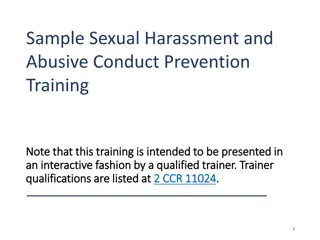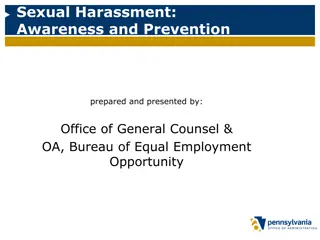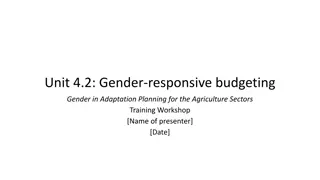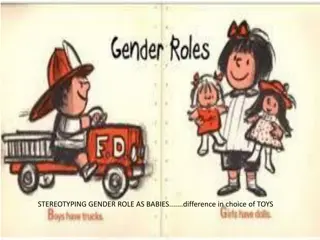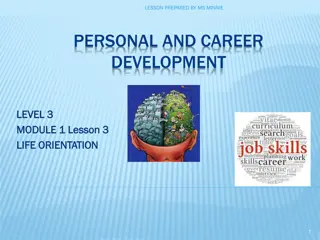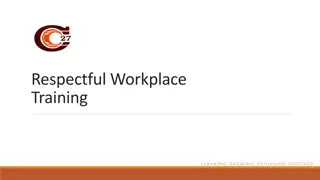Addressing Workplace Sexual Harassment: Action Steps for Gender Equality
Implementing effective strategies to address workplace sexual harassment by challenging attitudes, promoting gender equity in leadership, challenging stereotypes, and providing education and support for all employees. Drivers include recognition and challenge of discriminatory behaviors, setting gender equity targets, challenging gender stereotypes, and supporting non-traditional workplace roles.
Download Presentation

Please find below an Image/Link to download the presentation.
The content on the website is provided AS IS for your information and personal use only. It may not be sold, licensed, or shared on other websites without obtaining consent from the author. Download presentation by click this link. If you encounter any issues during the download, it is possible that the publisher has removed the file from their server.
E N D
Presentation Transcript
GENDERED DRIVERS OF SEXUAL HARASSMENT ACTION STEPS Each of the four gendered drivers have five suggested actions your organisation can take to address workplace sexual harassment. These are not the only actions you can take. The actions you take will depend on your own existing culture and context. We recommend you take actions that are doable, are relevant for your organisation and will make the most impact. You can use this slide deck and images as you wish. You can edit and adapt to your own context and use them for educational and/or communication purposes.
DRIVER 1 Recognise and challenge attitudes and beliefs that justify, excuse, trivialize, or downplay sexual harassment in the workplace. Challenge attitudes 1 Recognise and challenge discrimination based on gender, race, sexuality, disability and other discriminatory attitudes. 2 Challenge discrimination Challenge the condoning of sexual harassment Conduct a review of policies and procedures to analyse the practices that implicitly or explicitly condone sexual harassment in the workplace. Review policy 3 Create opportunities for workers to discuss workplace culture issues and identify practices that may implicitly or explicitly condone sexual harassment in the workplace. Encourage discussion 4 Ensure your workforce understands what behaviours and actions constitute sexual harassment. Inform the workforce 5
DRIVER 2 Plan for gender equity in leadership positions, with timeframes, milestones and accountability built in. Set gender equity targets 1 Recognise and promote the achievements of women in the workplace and create pathways and opportunities for women in leadership. 2 Promote independence Promote women s independence and decision- making in the workplace Conduct a type of audit to discover your workplace characteristics how male-dominated is your workplace, who makes the decisions and how hierarchical is your structure? Review workplace settings 3 Who speaks up Identify who speaks up in meetings and forums. Facilitate a process that ensures women have a voice. 4 Ensure your workforce understands that you promote women s independence and decision-making in your workforce. Inform the workforce 5
DRIVER 3 Recognise and challenge gender stereotypes in your organization. Consider the roles people have and how they create power imbalances. Challenge stereotypes 1 Challenge the way things are done around here Recognise workplace habits that are based on gender. These can be organisational and/or individual. Particularly important for male dominated workplaces. 2 Build a culture that fosters personal identities that are not constrained by rigid gender stereotypes Educate and support leaders to recognise disrespect in the workplace, particularly within male groups showing disrespect toward women. Recognise disrespect 3 Make it clear that your organisation encourages and supports its workers to speak up when witnessing disrespectful behaviours and ensure processes are in place for appropriately reporting and responding to disrespectful behaviours. Encourage speaking up 4 Support non-traditional roles Plan and support for non-traditional gender-based workplace roles. 5
DRIVER 4 Provide education and challenge gender bias Develop education and training opportunities for workers on positive workplace cultures that challenges gender bias, particularly in areas of recruitment, promotion and workplace diversity. 1 Develop a mentoring program for leaders and workers that focuses on positive and healthy relationships in the workplace. 2 Support mentoring Support men in developing healthy masculinities and positive, supportive male peer relationships Recognise achievements Reward positive behaviours that show respect and support for colleagues. 3 Promote positive relationships Actively promote positive relationships at work that demonstrate healthy masculinities and respect. 4 Encourage networks within the organisation that support positive male peer relationships, such as social events and interest groups. Support networks 5














